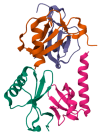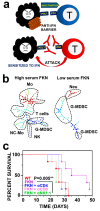Fractalkine in Health and Disease
- PMID: 39125578
- PMCID: PMC11311528
- DOI: 10.3390/ijms25158007
Fractalkine in Health and Disease
Abstract
CX3CL1 is one of the 50 up-to-date identified and characterized chemokines. While other chemokines are produced as small, secreted proteins, CX3CL1 (fractalkine) is synthetized as a transmembrane protein which also leads to a soluble form produced as a result of proteolytic cleavage. The membrane-bound protein and the soluble forms exhibit different biological functions. While the role of the fractalkine/CX3CR1 signaling axis was described in the nervous system and was also related to the migration of leukocytes to sites of inflammation, its actions are controversial in cancer progression and anti-tumor immunity. In the present review, we first describe the known biology of fractalkine concerning its action through its cognate receptor, but also its role in the activation of different integrins. The second part of this review is dedicated to its role in cancer where we discuss its role in anti-cancer or procarcinogenic activities.
Keywords: FKN; Neurotactin; PD-1; PD-L1; T-cell; dendritic cell; immune checkpoint; immunotherapy.
Conflict of interest statement
The authors declare no conflicts of interest.
Figures



Similar articles
-
CX3CL1 (Fractalkine)-CX3CR1 Axis in Inflammation-Induced Angiogenesis and Tumorigenesis.Int J Mol Sci. 2024 Apr 25;25(9):4679. doi: 10.3390/ijms25094679. Int J Mol Sci. 2024. PMID: 38731899 Free PMC article. Review.
-
Integrins αvβ3 and α4β1 act as coreceptors for fractalkine, and the integrin-binding defective mutant of fractalkine is an antagonist of CX3CR1.J Immunol. 2012 Dec 15;189(12):5809-19. doi: 10.4049/jimmunol.1200889. Epub 2012 Nov 2. J Immunol. 2012. PMID: 23125415 Free PMC article.
-
Role of the CX3CL1-CX3CR1 axis in renal disease.Am J Physiol Renal Physiol. 2021 Aug 1;321(2):F121-F134. doi: 10.1152/ajprenal.00059.2021. Epub 2021 Jun 14. Am J Physiol Renal Physiol. 2021. PMID: 34121453 Review.
-
Fractalkine/CX3CR1 signalling in chronic pain and inflammation.Curr Pharm Biotechnol. 2011 Oct;12(10):1707-14. doi: 10.2174/138920111798357465. Curr Pharm Biotechnol. 2011. PMID: 21466443 Review.
-
The Impact of the CX3CL1/CX3CR1 Axis in Neurological Disorders.Cells. 2020 Oct 13;9(10):2277. doi: 10.3390/cells9102277. Cells. 2020. PMID: 33065974 Free PMC article. Review.
References
Publication types
MeSH terms
Substances
Grants and funding
- FIS PI23/00196/Instituto de Salud Carlos III-FEDER
- FIS PI20/00010/Instituto de Salud Carlos III-FEDER
- BMED 036-2023/Departamento de Salud del Gobierno de Navarra-FEDER, Spain
- LINTERNA, Ref. 0011-1411-2020-000033/Departamento de Industria, Gobierno de Navarra, Spain
- ARNMUNE, 0011-1411-2023-000111/Departamento de Industria, Gobierno de Navarra, Spain
LinkOut - more resources
Full Text Sources
Research Materials
Miscellaneous

